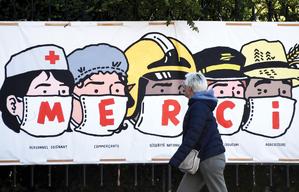Emerging from the pandemic have been calls for European solidarity and even further integration
 Switzerland’s Matterhorn mountain is illuminated with the Chinese flag on April 19. Flags of countries have lighted the mountain each day since March 24 to show solidarity during the pandemic. (PHOTO / XINHUA)
Switzerland’s Matterhorn mountain is illuminated with the Chinese flag on April 19. Flags of countries have lighted the mountain each day since March 24 to show solidarity during the pandemic. (PHOTO / XINHUA)
Wearing a self-made face mask, Angele Kedaitiene has been walking for up to two hours in Parc du Cinquantenaire near her home in central Brussels every day for the past month since a nationwide lockdown was imposed in Belgium due to the COVID-19 outbreak.
“It helps keep me fit and also enables me to see that the world is still functioning and even smiling,” she said, adding that it is important to keep social distancing in the 30-hectare park.
A former official at the European Commission, with a doctorate in environmental statistics, Kedaitiene is lecturing online and writing articles at home, but she is looking forward to restrictions being eased.
“I have used the time productively. Nevertheless, the lockdown is difficult to handle, especially when you cannot see friends and colleagues, or go to the coast in good weather,” she said.
Belgian Prime Minister Sophie Wilmes was quoted by the newspaper Le Soir on April 19 as saying the government would announce new measures to ease restrictions on April 24, adding that the plan would be accompanied by a series of conditions.
Last week, the Belgian government announced it would allow do-it-yourself stores to reopen by April 20, as long as all safety measures were in place.
The country’s National Security Council has extended the lockdown from April 19 to May 3.
Some other European Union nations have also moved toward loosening restrictions.
On April 19, French Prime Minister Edouard Philippe said that in the next two weeks a plan would be announced to progressively lift restrictions imposed on the travel and business sectors. Last week, French President Emmanuel Macron said the country’s lockdown would be extended until May 11.
Philippe said: “Our lives after May 11 will not be exactly the same as before the lockdown. Not immediately, and probably not for a long time.”
On April 15, German Chancellor Angela Merkel announced a gradual easing of lockdown measures imposed on March 22.
Stores of up to 800 square meters were allowed to reopen on April 20, on condition that “plans to maintain hygiene” were in place.
Car dealers, bike shops and bookstores have also been allowed to reopen, but hairdressers will only be permitted to do so from May 4. Schools will be allowed to reopen gradually from this date, but large gatherings will remain prohibited until the end of August at the earliest.
Merkel recommended that face masks be worn in stores and on public transportation, but did not make this compulsory.
 A poster thanks essential workers in the French capital on April 14, the 29th day of the country’s lockdown. (FRANCK FIFE / AFP)
A poster thanks essential workers in the French capital on April 14, the 29th day of the country’s lockdown. (FRANCK FIFE / AFP)
Global movement
German Health Minister Jens Spahn said last week the novel coronavirus outbreak was under control, as the number of patients who had recovered had been consistently higher than the figures for new infections.
The country has been viewed as one of the best EU member states in tackling COVID-19, given its aggressive measures adopted for massive testing and contact tracing, strong hospital system and a relatively disciplined population.
In neighboring Austria, restrictions started to be eased on April 14, when the government allowed garden centers, DIY stores and small stores to reopen. Other stores and hairdressers can reopen from May 1.
Margarete Schrambock, the country’s economics minister, told Austrian TV: “Experience in countries that have handled it (the outbreak) well has taught us that we have to move gradually.”
On April 17, the Austrian government announced that cultural sites, such as museums and libraries, would be allowed to reopen from the middle of next month.
Austria is one of the few EU countries where wearing face masks is compulsory. On March 30, the government announced that supermarket customers would be required to wear masks, provided free at the stores.
The Czech Republic, where wearing face masks became compulsory even earlier than in Austria, said last week that craft stores would be allowed to reopen on April 20, followed by larger stores on May 11 and restaurants and shopping malls on June 8.
Wearing masks will remain compulsory until further notice.
Deputy Prime Minister Karel Havlicek told a news conference: “This scenario is based on a parameter where the coronavirus is under control, as it has been until now.”
Last week, Denmark reopened schools for pupils younger than 12, and on April 20 it allowed hairdressers, tattoo parlors and dentists to resume business for the first time since a lockdown was imposed on March 12.
Courts are expected to reopen on April 27, while restaurants, cafes and schools for students aged 12 and older will remain closed.
Italy, the hardest hit of the 27 EU member states, has also lifted some restrictions, allowing bookstores and children’s clothing shops to reopen on condition that customers wear face masks and gloves. Other lockdown measures in the country will remain in place until May 3 at the earliest.
Spain, with the highest number of confirmed cases in the EU, has allowed tentative reopening by construction and manufacturing businesses since April 13. The government has advised people returning to work to wear face masks whenever social distancing is not possible.
On April 18, Spanish Prime Minister Pedro Sanchez said that while the country had seen a decline in the number of new cases and deaths, he would ask parliament to extend the lockdown for two weeks. It is due to expire on April 26.
Portuguese Prime Minister Antonio Costa said on April 18 that he hoped his government would be able to begin lifting the lockdown next month.
“It will have to be gradual, progressive and controlled, so that we don’t lose in May what we’ve gained in the past two months,” he said, adding that small neighborhood stores would likely open first.
He said the government could announce procedures for easing restrictions on April 30. On April 17, the lockdown in Portugal was extended until May 2.
 Dutch disc jockey Luc Sarneel, right, surprises the grandparents of a 23-year-old woman, left on platform, in Drachten, the Netherlands, on April 13 during a radio show recording to raise money for the Red Cross. (KEES VAN DE VEEN / ANP / AFP)
Dutch disc jockey Luc Sarneel, right, surprises the grandparents of a 23-year-old woman, left on platform, in Drachten, the Netherlands, on April 13 during a radio show recording to raise money for the Red Cross. (KEES VAN DE VEEN / ANP / AFP)
By introducing social distancing at an early stage, Portugal has been successful in battling COVID-19. The mortality rate in the country from the disease is just over 3 percent, compared with 10 percent in neighboring Spain, 13 percent in Italy, 14 percent in Belgium and 17 percent in France, according to a World Health Organization report on April 18.
Borge Brende, president of the World Economic Forum and a former Norwegian foreign minister, said: “In these countries, governments are now exploring how to relax measures. It is, though, incredibly important to avoid a second wave (of infections).”
In Europe as a whole, more than 1 million confirmed cases and 100,000 deaths from the virus had been reported by April 19.
On Jan 30, WHO Director-General Tedros Adhanom Ghebreyesus declared the outbreak a Public Health Emergency of International Concern — its highest-level alert — one day before Italy reported its first two confirmed cases.
By Feb 21, a cluster of cases had been confirmed in Lombardy in the northwest of the country. The number of cases then grew exponentially. By the time Italian Prime Minister Giuseppe Conte signed a decree on March 8, enforcing quarantine in Lombardy and several other provinces, Italy had 5,883 confirmed cases and 234 deaths. The following day, the lockdown was extended nationwide.
By April 18, the number of confirmed cases in the country had exceeded 172,000, with 22,000 deaths, the highest mortality figure among EU member states.
Universal health coverage is provided in Italy, but nearly 23 percent of the population is older than 65, trailing only Japan. According to a National Institute of Health report quoted by Al Jazeera late last month, more than 85 percent of those who have died from COVID-19 were older than 70, and 48 percent of the deceased had an average of three pre-existing illnesses.
Close family connections have also been viewed as a reason for the virus spreading in Italy, with the elderly interacting much more with their children and grandchildren compared with their counterparts in other countries.
On March 13, the WHO declared Europe the epicenter of COVID-19 after Spain and several other countries reported fast-growing numbers of cases and deaths. Two days earlier, the WHO had declared COVID-19 a global pandemic.
Spain, which reported its first confirmed infection on Jan 31, had registered cases in all its 50 provinces by March 13, one day before a national lockdown was imposed.
As of April 20, the country had reported more confirmed cases than Italy, but the death toll in the country from the virus was still lower than its European counterpart’s.
When the WHO announced a Public Health Emergency of International Concern on Jan 30, most EU countries did not take it seriously. A Harvard Business Review article published on March 27, titled “Lessons from Italy’s Response to Coronavirus”, said: “The initial state-of-emergency declarations were met by skepticism by both the public and many in policy circles — even though several scientists had been warning of the potential for a catastrophe for weeks.”
The lack of a coordinated approach nationwide has been cited as one cause of the virus spreading when many people fled to southern Italy after the lockdown was imposed in the north of the country on March 8.
In Spain, hundreds of thousands of people took to the streets in several cities on March 8 for an International Women’s Day protest despite concerns over the virus.
With the elderly the most susceptible to infection, nursing homes in several European countries have been hit hard in the past two months.
A report by academics at the London School of Economics shows that between 42 percent and 57 percent of deaths from the virus in Italy, Spain, France, Ireland and Belgium have been reported in nursing homes.
In Sweden, the only EU member state not to impose social distancing and lockdown measures, one-third of COVID-19 fatalities have occurred in nursing homes. The country has banned gatherings of more than 50 people, closed high schools and universities, and urged people older than 70 to self-isolate. But elementary schools, restaurants and bars have remained open.
Early discord
The Swedish government’s policy has faced mounting criticism, with the number of new cases and deaths rising rapidly in the past few weeks. According to a WHO report on April 18, Sweden had 13,216 confirmed cases and 1,400 deaths, much more than Finland, Norway and Denmark, which have imposed lockdowns and social distancing.
On April 19, the Daily Mail in the United Kingdom quoted Anders Tegnell, Sweden’s state epidemiologist and the man behind the country’s controversial policy, as saying that the population of Stockholm, the capital and epicenter of the outbreak in Sweden, could achieve “herd immunity” as early as next month.
Brende, from the World Economic Forum, said: “It has become clear that having both a prepared and resilient health system, and a population and government who are willing to act early and decisively, are the biggest strengths in this crisis.”
COVID-19 has also hit political and economic unity among EU member states, with countries unilaterally closing their borders, restricting exports of medical supplies and failing to coordinate on lockdown strategies.
On March 17, European Commission President Ursula von der Leyen finally proposed a 30-day ban on unnecessary travel to the bloc. The commission also asked the four non-EU member states in the Schengen Area — a visa-free travel zone — to adopt the ban. “The less travel, the more we can contain the virus,” Von der Leyen said at the time.
During the early stages of the pandemic, Germany and France were condemned by other EU member states for banning exports of vital medical supplies. On March 15, the European Commission announced an export ban for some protective medical equipment, in an attempt to maintain sufficient supplies within the bloc.
According to European Commissioner for Crisis Management Janez Lenarcic, the biggest alarm came at the end of February when Italy requested assistance. “There was no response,” he said.
An opinion poll last month found that 88 percent of Italians felt the EU had failed to support their country, and on April 2, Von der Leyen apologized to the country for a lack of solidarity in tackling the crisis. She did so again on April 16.
“Too many were not there on time when Italy needed a helping hand at the very beginning. And yes, for that, it is right that Europe as a whole offers a heartfelt apology,” she told the European Parliament.
Kedaitiene, the former EU official, said critics are right about the bloc’s response to COVID-19. But she added that the EU has learned lessons from the financial crisis of 2008. “The financial institutions are more powerful, resilient and better equipped,” she said.
On April 17, the European Parliament passed a resolution calling for a massive recovery package to support the bloc’s economy after the outbreak, including bonds guaranteed by the EU budget.
Brende praised the EU for “adapting and progressing” through this crisis, citing its financial packages announced in recent weeks.
He said EU leaders are “united in calling for European solidarity, and are even contemplating further political integration”.
The Guardian and Politico contributed to the reporting.


